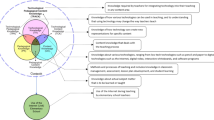
Amidst the contemporary shifts within early childhood education (ECE) in China, the significance of multimedia tools and their effective deployment by educators is increasingly paramount. Situated within the theoretical underpinnings of the Technology Acceptance Model (TAM), this inquiry elucidates the intricate dynamics between the Perceived Usefulness (PU) and Perceived Ease of Use (PEU) of said tools and their consequential influence on educators’ effectiveness. Empirical data gleaned from a rigorous quantitative survey of 400 educators within ECE institutions in Guangdong Province underscore the importance of PU and PEU as determinants of the successful assimilation of multimedia tools, thereby influencing the pedagogical efficacy of educators. There are several implications of this investigation. The study primarily contributes to the academic discourse by bridging a discernible lacuna and offering insights into multimedia tool adoption dynamics within the specific milieu of ECE in China. The findings have implications for a spectrum of stakeholders, from multimedia tool developers to educational policy-makers, underscoring that tools, to be truly transformative, must be perceived as both intrinsically valuable and user-centric. Notwithstanding the robustness of the findings, the geographically circumscribed focus on Guangdong Province warrants prudence in generalizing insights across China. This suggests the need for future scholarly endeavours to broaden the research purview across diverse provinces, aspiring to provide a more holistic understanding of the dynamics of multimedia tool integration within China’s expansive ECE domain.


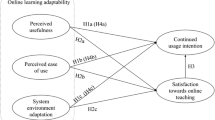
In the contemporary landscape, rapid advancements in multimedia technologies are significantly transforming educational practices worldwide (Shunkov et al., 2022). This technological shift is especially pronounced in China’s Early Childhood Education (ECE) sector (Nisak et al., 2022), where professionals educators play a pivotal role. These roles emphasise their contributions that extend beyond conventional teaching to a wide range of nurturing, mentoring, and developmental responsibilities. The emergence of the educator aligns with directives from China’s central government in 2019 (Central People’s Government of the People’s Republic of China, 2019). However, as multimedia tools become increasingly embedded in educational arenas, educators are challenged with leveraging their capabilities to optimize their effectiveness (Sudarsana, 2018).
Using multimedia tools extends beyond mere access; it encompasses acceptance and skilful implementation of such technologies. In this context, the Technology Acceptance Model (TAM) offers a comprehensive framework to decipher the variables affecting technology utilization (Davis et al., 1989). A noticeable void exists in the current literature regarding the influence of multimedia on educator effectiveness in China, signalling a research opportunity.
Addressing this gap, our study delves into how multimedia applications, grounded in TAM principles, impact educator effectiveness in Guangdong Province, China. The research makes multiple contributions. Primarily, it shapes educational strategies and methodologies by shedding light on factors influencing educator effectiveness in multimedia applications. Furthermore, employing TAM to analyse multimedia dynamics as used by educators, this study introduces a fresh perspective, especially considering the specific cultural and regional background.
This research endeavours to elucidate multimedia utilization and its repercussions on educators’ effectiveness. We aim to explore the interplay of TAM variables, including Multimedia of Perceived Usefulness (PU), Perceived Ease of Use (PEU), and their bearing on Educators’ Effectiveness (EE) in Guangdong Province, China. To realize this, a quantitative survey method is adopted, targeting educators from the province’s ECE domain.
Our study’s paramount contribution lies in the novel application of TAM to ECE in China. The insights promise to demystify the determinants fuelling the successful integration of multimedia technologies in education, potentially amplifying educator effectiveness and enriching ECE quality (Livingstone et al., 2019). Consequently, this inquiry stands at the juncture of technology acceptance, education, and productivity, heralding both theoretical innovations and tangible enhancements in the domain.
China’s evolving ECE landscape, particularly in Guangdong Province, has led to the emergence of educators as a distinctive role that unifies educational and caregiving responsibilities (Kong, 2023; Zhao et al., 2022). These professionals cultivate children’s holistic development and facilitate a vital communication bridge between homes and educational institutions (Arvola et al., 2021). Nevertheless, Guangdong’s flourishing ECE sector must also grapple with maintaining quality standards and addressing the scarcity of adequately trained educators (Oon et al., 2019).
The educator role originated from the unique societal and policy context in China. The pivotal turning point came in 2019 when the Chinese central government decreed the provision of care services for infants and toddlers under three years of age (Central People’s Government of the People’s Republic of China, 2019). Consequently, the scope of the role expanded beyond traditional educational duties to incorporate professional caregiving services. This broader remit led to reconsidering the term ECE educator and represents a more refined classification within ECE, acknowledging these professionals’ distinct and substantial contributions during children’s critical early developmental stages.
The emergence of this role has its challenges. The scarcity of qualified educators and escalating demand for ECE services have heightened concerns regarding the quality of care and education in some contexts. Moreover, the inconsistent availability of ongoing professional development opportunities, critical for enhancing educators’ competencies and practices, compounds these challenges (Logan et al., 2020).
Efforts towards improving ECE are evident in China’s ongoing policy initiatives, encompassing national and regional strategies to enhance early childcare services (Central People’s Government of the People’s Republic of China, 2019; Guangdong Provincial People’s Government, 2020). As the integration of new media technology becomes more commonplace in ECE settings, educators are poised at the intersection of numerous opportunities and challenges within this rapidly evolving educational milieu.
Multimedia technologies, a critical facet of modern education, encompass interactive, digital, and combined media to enhance teaching and learning experiences (Neo and Neo, 2004). This includes digital tools, such as tablets, software applications, video and audio tools, interactive whiteboards, and online platforms. They enable a combination of text, graphics, sound, animation, and video to create engaging, multisensory learning environments (Kamran, 2019).
In today’s technological environment, these multimedia technologies have markedly influenced global ECE practices, including those in China. Recognizing the pivotal role technology plays in education, the Chinese government has been proactively fostering its integration, catalysing technology adoption within ECE environments (Adarkwah, 2021).
Many digital tools and resources have been ingeniously woven into China’s ECE curricula to enhance children’s learning experiences and facilitate the acquisition of essential 21st-century competencies (Weng and Li, 2018). In addition, the proliferation of multimedia technologies has diversified communication and collaboration channels among educators, children, and parents, enabling remote and flexible learning paradigms (Anderson and Rivera Vargas, 2020). Government initiatives, such as the “Internet Plus” education strategy and the “National Outline for Medium and Long-term Education Reform and Development (2010–2020)”, illustrate China’s commitment to encouraging technology use in educational settings, including ECE (Li et al., 2016).
However, the extent of multimedia technology integration within Chinese ECE contexts varies and is influenced by factors such as geographical location, funding availability, and access to resources (Luo et al., 2023). While urban ECE institutions equipped with advanced digital resources are typically at the vanguard of this shift, rural institutions grapple with infrastructural, financial, and access-related challenges (Hu et al., 2021).
Given this scenario, there is a critical need for professional development and training programs that equip educators with the necessary skills to efficiently integrate multimedia technologies into their pedagogical practices. Thus, understanding the factors contributing to successful technology adoption in Chinese ECE settings and the specific roles and experiences of educators within technology-enhanced ECE environments is a crucial avenue for future research.
Multimedia technologies’ integration within ECE offers notable benefits but, at the same time, poses some challenges. A thorough understanding of both aspects is instrumental to enhancing the practical application of technology in ECE settings.
Multimedia technologies stand to significantly improve children’s learning experiences (Naluwooza et al., 2023). They foster learner engagement, enable personalized learning experiences, and expand access to diverse learning resources (Ismoilovich and Ravshanbekovich, 2023). With multimedia-enhanced learning activities, children can develop critical 21st-century skills such as creativity, problem solving, and critical thinking (Alzubi, 2023). Furthermore, multimedia technologies offer educators refined methods for assessing learner progress and addressing individual needs. They enhance stakeholder communication and collaboration and provide the groundwork for flexible, remote learning environments. Finally, they can foster continuity between home and school learning environments (Sonnenschein et al., 2021).
However, incorporating multimedia technologies into ECE settings is challenging (Lindeman et al., 2021). For example, excessive screen time poses potential risks to children’s physical health and social development (Kaimara et al., 2022). Organizations such as the American Academy of Paediatrics advise limited screen time for young children and underscore the importance of educator and parental supervision (Przybylski, 2019).
Educators may also need help integrating technology into their practices due to technical skill gaps, inadequate training, or resource limitations (Hu et al., 2021). These challenges necessitate ongoing professional development and adequate support for educators.
The digital divide—a disparity in access to digital resources—can intensify existing inequalities in educational opportunities among children from different socioeconomic backgrounds (Reddick et al., 2020). Thus, ensuring equitable access to multimedia technologies is critical to delivering inclusive, high-quality ECE experiences.
Hence, despite the manifold benefits multimedia technologies offer for ECE, it is vital to navigate the associated challenges to ensure meaningful, effective, and equitable technology integration. Understanding educators’ experiences within technology-enhanced ECE environments and identifying the factors influencing successful technology adoption are critical steps towards optimizing multimedia technology use in early childhood education.
The multimedia integration in ECE is not just a matter of technological innovation; it represents a significant shift in pedagogical practices and educator roles. This nexus between technology and education offers a compelling backdrop to understand the evolving role of educators and the factors that affect their effectiveness.
Mertala (2019) highlighted the nuanced roles of teachers beyond imparting education. They also attend to students’ emotional, physical, and social needs and their role in society. Teachers’ beliefs and attitudes become paramount when introducing technology, especially multimedia tools, into the educational sphere. Mertala suggests that there is a critical role that educators’ beliefs play in shaping their approach to technology. However, while Mertala brings to light the importance of beliefs, there is a gap in understanding how these beliefs directly influence the effectiveness of educators in utilizing multimedia in their teaching.
Drawing insights from Latini et al. (2020), the choice of medium for reading, whether print or digital, has been shown to affect comprehension processes. Their study suggests that participants exhibited more integrative processing with printed than digital materials. This raises critical questions about the potential challenges educators might face while leveraging multimedia resources. If comprehension is affected by the medium, then understanding how this affects the effectiveness of educators in imparting knowledge remains to be fully explored.
Li et al. (2019) extensively analysed multimedia learning trends over two decades. While they identified prevailing themes and trends, such as the importance of cognitive load and animation in multimedia learning, their practical application and impact on educator effectiveness are underresearched. Knowing the trends is essential, but how they align with the day-to-day practices of educators and their efficacy in diverse educational settings is an area our study seeks to explore further.
Gong (2022) discussed the confluence of multimedia technology and children’s drama education. The study highlighted the promising potential of human–computer interaction technologies in preschool drama education. However, while the tools and methodologies are advancing, understanding the nuances of how educators adapt to and effectively implement these tools in their curriculum is a dimension that needs to be deeply examined by Gong.
Last, Coskun and Cagiltay (2022) used eye-tracking metrics to understand learners’ cognitive processes in animated multimedia settings. Their insights provide a nuanced understanding of the relationship between design, attention, and learning outcomes. However, how educators can harness this understanding to improve their effectiveness, especially when animations and simulations become standard tools, remains an area with potential for further inquiry.
Our research aims to fill the gaps identified above by examining the direct impact of multimedia tools and methodologies on the effectiveness of educators. We seek to understand how these multimedia advancements, while promising on the surface, translate into real-world effectiveness in educational contexts, especially in Guangdong Province. Our inquiry aims to provide a more grounded perspective that juxtaposes the promise of multimedia with the practical realities and challenges faced by educators.
The Technology Acceptance Model (TAM), developed by Davis et al. (1989), is a seminal theoretical framework in information systems (Granić, 2023). Crafted to predict and understand user acceptance and utilization of information technology, TAM pivots around two principal determinants: Perceived Usefulness (PU) and Perceived Ease of Use (PEU) (Warsono et al., 2023).
As shown in Fig. 1, both PU and PEU are directly linked to an individual’s Behavioural Intention to Use (BIU), a system within the TAM framework. When educators perceive multimedia technology to be advantageous (PU) and user-friendly (PEU), their intention to integrate and employ that technology (BIU) increases. This intention ultimately materializes as Actual System Use, representing the integration and use of multimedia tools in their teaching methods.
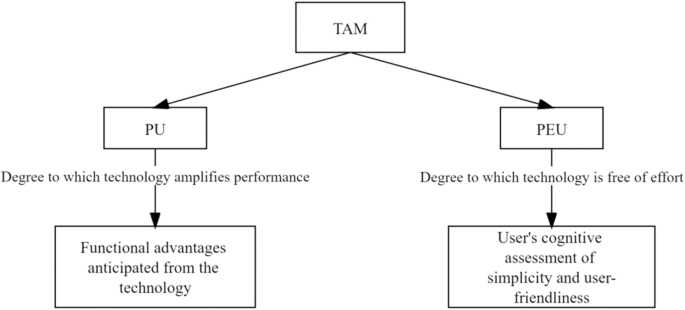
In the context of our research, which probes the effects of multimedia on the effectiveness of educators, TAM serves as an instrumental analytical framework. Utilizing TAM, we can systematically analyse how educators evaluate multimedia technologies regarding their perceived advantages and user accessibility. Furthermore, by integrating specific external variables pertinent to the educational realm—such as institutional guidelines, pedagogical training, or curriculum directives—we can direct our insights towards the factors influencing the acceptance and adaptation of multimedia tools by educators.
Building on these theoretical foundations, our research model and hypotheses will explore the complex interplay between perceived ease of use, perceived usefulness, and the diverse external variables that influence an educator’s decision to incorporate multimedia technologies into educational strategies.
The TAM has become instrumental in probing the determinants driving technology adoption, especially within educational landscapes. It is highly pertinent when integrating multimedia technology into teaching paradigms. At the heart of this examination lies the quest to discern educators’ perspectives on the benefits and ease of using such multimedia tools. Based on the solid foundations of TAM, the present study seeks to debunk the hidden correlations between educators’ adoption of multimedia technology and their subsequent effectiveness.
Two pivotal independent variables underscore this inquiry. First, the PU serves as a barometer measuring the extent of educators’ conviction that multimedia tools can bolster the quality of their pedagogical endeavours. This translates into gauging the level of agreement among educators that multimedia-rich content can curate a learning experience that is in-depth and interactive for students. Complementing this is the second variable, PEU, which focuses on the anticipations of educators regarding how seamlessly multimedia technology can be woven into their teaching fabric. The underlying contemplation is whether educators perceive these technologies as intuitive additions to their teaching arsenal, bereft of any substantial impediments.
By synthesizing these several strands, the focal point that emerges is the dependent variable of Educators’ Effectiveness (EE). This encapsulates the tangible, positive repercussions observed when multimedia instruments are deployed in instructional settings. Effectiveness is broadly conceived, ranging from a palpable surge in student engagement to discernible strides in learning outcomes or even the clarity of feedback on delivered content.
Based on the above, we formulate the following hypotheses. Figure 2 shows the variables and their hypothesized relationships.
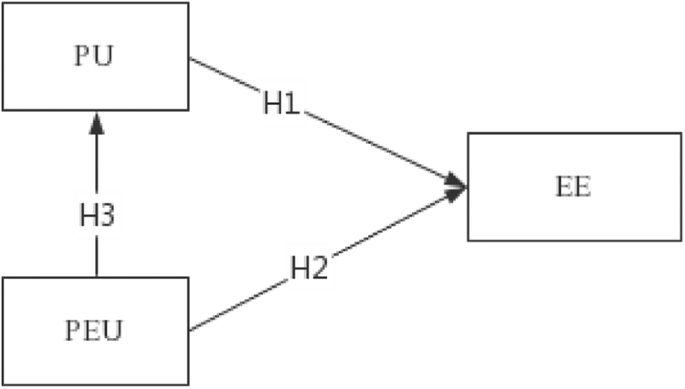
Hypothesis 1 (H1): The PU of multimedia tools significantly affects EE.
Hypothesis 2 (H2): The PEU of multimedia tools significantly affects EE.
Hypothesis 3 (H3): PEU significantly affects the PU of multimedia tools among educators.
This study leverages a quantitative research design and employs a meticulously crafted questionnaire to extract insights from educators, parents, and other pivotal stakeholders within ECE in Guangdong Province, China. The focus is to elucidate participants’ demographics and perceptions of multimedia technology’s PU and PEU and its influence on the effectiveness of educators in ECE.
Our questionnaire is influenced by the foundational works of Davis et al. (1989) and Seligman (2001) for the PU and PEU dimensions. Notably, while Seligman’s original research revolved around computer-based patient records (CBPR), we adapted his items, replacing “CBPR” with “multimedia technology in ECE” to better fit our study context. A 5-point Likert scale was used for all items covered by the variables, with 1 indicating strong disagreement and 5 indicating strong agreement.
Below Table 1 presents the dimensions, their corresponding items, the item number, and the originating sources:
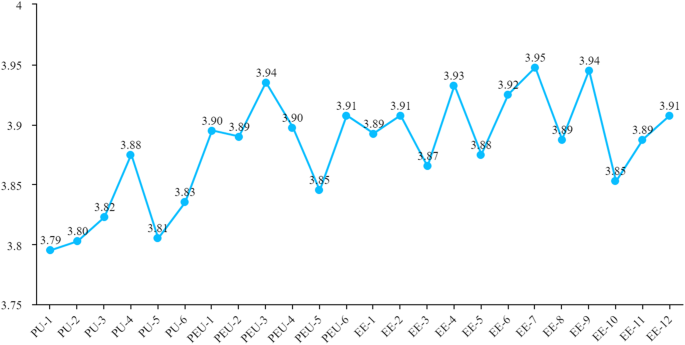
For the PU measures, the average responses range between 3.795 and 3.875. This suggests that participants, on average, leaned towards agreeing that the multimedia tools were helpful, as these scores are closer to 4 on a 5-point scale. The slight variations within this range are subtle, with PU-4 having the highest mean value of 3.875, indicating that this aspect of perceived usefulness had the highest agreement among respondents. Regarding the PEU domain, the average responses span from 3.845 to 3.935, which implies that participants typically found multimedia tools relatively easy to use. The highest average value is for PEU-3 at 3.935, which might indicate a specific feature or aspect of the multimedia tool that was particularly intuitive for the respondents. For EE, the mean values fluctuate between 3.853 and 3.947. These values again tilt towards the higher end of the scale, signifying that, on average, participants felt that multimedia tools enhanced the effectiveness of educators. Within this domain, EE-7 registers the highest mean value of 3.947, suggesting that participants most recognized or valued this specific dimension of effectiveness.
Table 6 presents various metrics assessing the fit of a statistical model.
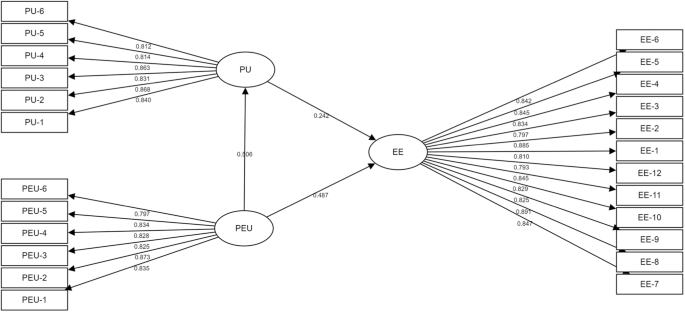
Our study aimed to explore the potential relationships between multimedia tools and PU and PEU and the resultant effects on EE. Drawing on the data and subsequent analyses, we arrive at the following conclusions concerning the hypotheses.
Overall, the conclusions drawn from our hypotheses provide a compelling narrative about the importance of both perceived usefulness and ease of use in the context of multimedia tools for educators. It is not merely about creating technologically sophisticated tools; it is about ensuring they align with the practical needs and comfort levels of educators. As the landscape of early childhood education in China continues to evolve, these insights offer critical guidance for both tech developers and educational policy-makers, emphasizing the need for tools that are both potent and accessible.
The intricate connection between technology, specifically multimedia tools, and education has been extensively examined in academic research. With the ever-evolving landscape of digital learning, it is imperative to understand the factors that influence the successful adoption and effectiveness of these tools. Our study, rooted in this context, offers several insights that warrant discussion.
First, our findings align with the broader literature that emphasizes the role of PU in technology adoption. The significant effect of PU on EE aligns with the tenets of the TAM, which posits that the perceived usefulness of technology is a primary determinant of its acceptance and use. This result underscores the importance for developers and educators alike to ensure that multimedia tools incorporate advanced features and are genuinely helpful in the intended context.
Our observation on the role of PEU sheds light on a critical aspect of technology implementation in educational contexts. The positive influence of PEU on educators’ effectiveness is a testament to the age-old adage: simplicity is the ultimate sophistication. It is about more than having a tool with many features; its potential benefits remain unrealized if it is not user-friendly. The influence of PEU on PU further cements the notion that tools perceived as easy to use are also deemed more practical. This interconnectedness suggests that usability and utility are not mutually exclusive but intertwined dimensions that educational technology developers must address concurrently.
In addition, the robust effect size of the relationship between PEU and PU is noteworthy. While usefulness is paramount, the ease with which educators can harness this usefulness is equally critical. This has significant implications for training and professional development programs. As institutions introduce new multimedia tools, they must ensure that support mechanisms are in place to make the transition smooth for educators.
However, our study is not without its limitations. Factors such as cultural nuances, institutional peculiarities, or regional specifics might affect the observed relationships. It is also relevant to highlight that our survey was conducted exclusively in Guangdong Province. As such, the findings may not be generalizable to other provinces in China, suggesting the need for caution when interpreting the outcomes.
In conclusion, our investigation stresses the significance of the association between perceived usefulness and ease of use in determining the effectiveness of multimedia tools for educators. As we navigate deeper into the digital age, these revelations serve not just as scholarly reflections but as essential guideposts for stakeholders straddling technology and education, mapping out the trajectory of digital education.
Given the geographical limitation of our study in Guangdong Province, future research could explore similar dynamics in other provinces of China to ascertain the generalizability of our findings. Cross-provincial comparisons might identify regional variances in the adoption and effectiveness of multimedia tools. In addition, longitudinal studies could be conducted to track changes in perceptions and usage patterns over time, offering insights into the evolving nature of digital learning. There is also a potential avenue to delve deeper into specific multimedia tool features and their direct impact on educators’ teaching methodologies and student outcomes. Ultimately, as technology continues to permeate educational settings, it is imperative for research to stay abreast of these developments, ensuring that tools are both relevant and effective in the ever-changing educational landscape.
The data are not publicly available due to privacy protection. The data that support the findings of this study are available on reasonable request from the corresponding author.
XT: Significantly contributed to establishing the conceptual framework and defining the research objectives. Led the primary data collection efforts and was instrumental in the extensive drafting and composition of the manuscript, ensuring a comprehensive presentation of the research findings. SRBMZ: Provided invaluable guidance and oversight throughout the research process. Her contributions were critical in refining the manuscript, offering essential insights for its improvement, and rigorously correcting any errors, thereby upholding the academic integrity and quality of the work. QL: Assisted effectively in the systematic collection of data. Responsible for the creation and curation of graphical elements and charts within the manuscript, enhancing its visual appeal and clarity. In addition, conducted thorough proofreading of the document, focusing on refining its linguistic accuracy and textual coherence.
The authors declare no competing interests.
Considering the study’s categorization within the social sciences domain, which neither encompasses sensitive subjects nor involves vulnerable populations, the submission of a formal ethical review application to the Universiti Sains Malaysia’s ethics committee was not required.
All participants were informed of the purpose and scope of the study and how the data would be used. They were also assured that their anonymity would be maintained and that no personal or identification information would be collected or disclosed. All participants gave their informed consent for inclusion before they participated in this research.
Publisher’s note Springer Nature remains neutral with regard to jurisdictional claims in published maps and institutional affiliations.
Open Access This article is licensed under a Creative Commons Attribution 4.0 International License, which permits use, sharing, adaptation, distribution and reproduction in any medium or format, as long as you give appropriate credit to the original author(s) and the source, provide a link to the Creative Commons license, and indicate if changes were made. The images or other third party material in this article are included in the article’s Creative Commons license, unless indicated otherwise in a credit line to the material. If material is not included in the article’s Creative Commons license and your intended use is not permitted by statutory regulation or exceeds the permitted use, you will need to obtain permission directly from the copyright holder. To view a copy of this license, visit http://creativecommons.org/licenses/by/4.0/.
Tang, X., Zainal, S.R.B.M. & Li, Q. Multimedia use and its impact on the effectiveness of educators: a technology acceptance model perspective. Humanit Soc Sci Commun 10, 923 (2023). https://doi.org/10.1057/s41599-023-02458-4
Anyone you share the following link with will be able to read this content:
Get shareable link
Sorry, a shareable link is not currently available for this article.
Copy to clipboard
Provided by the Springer Nature SharedIt content-sharing initiative